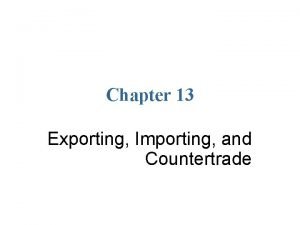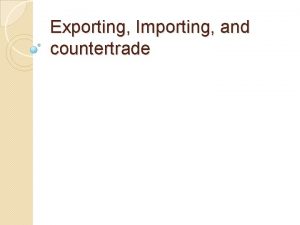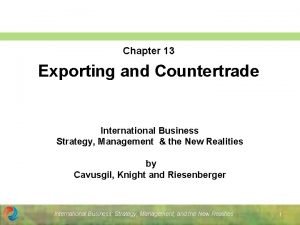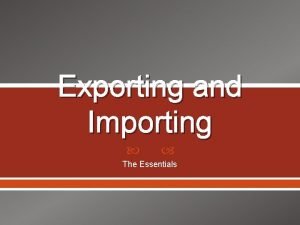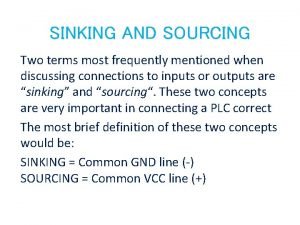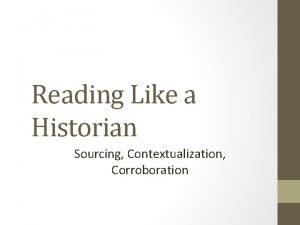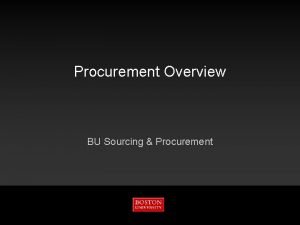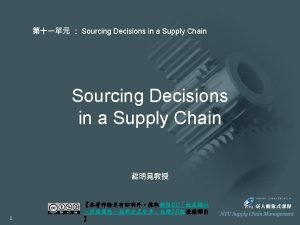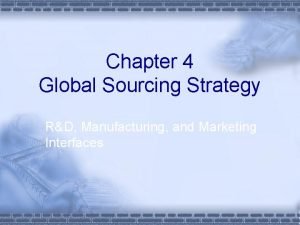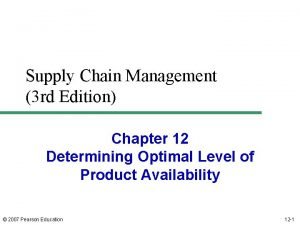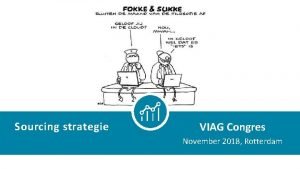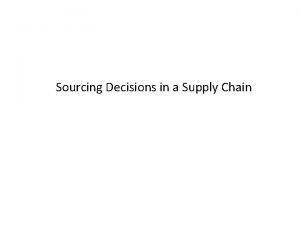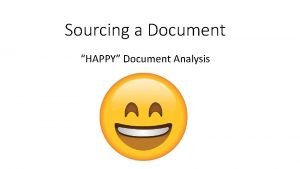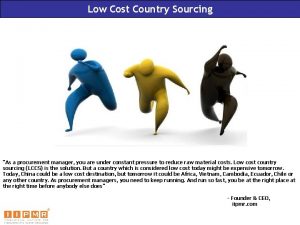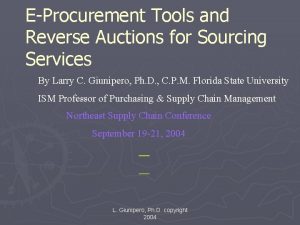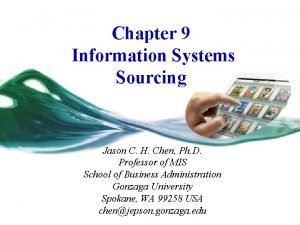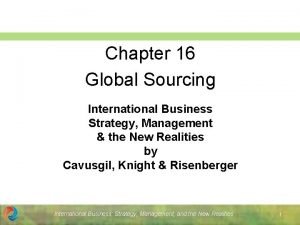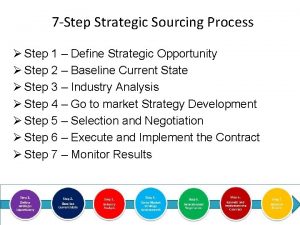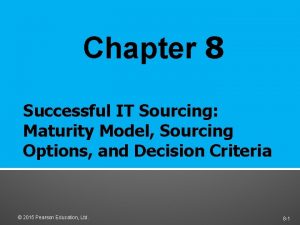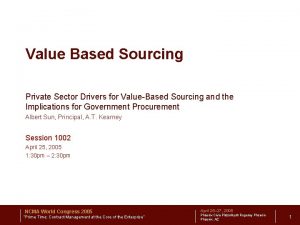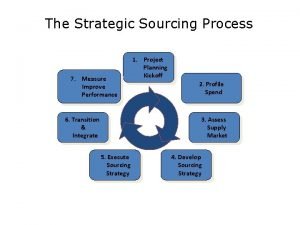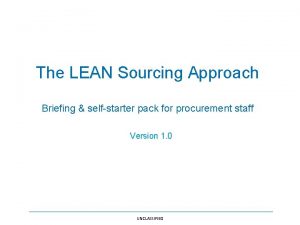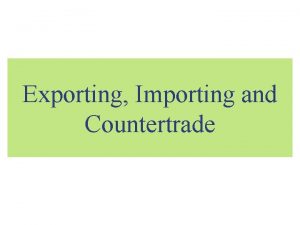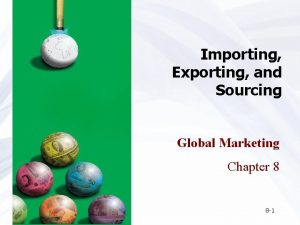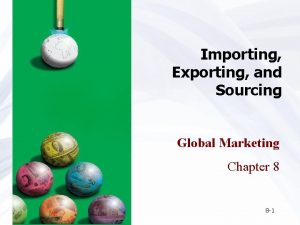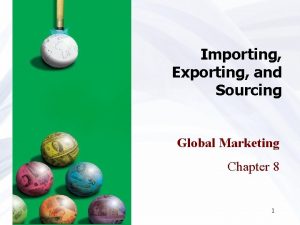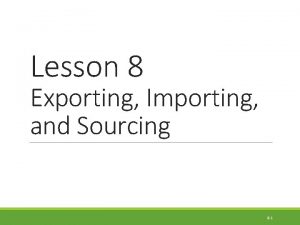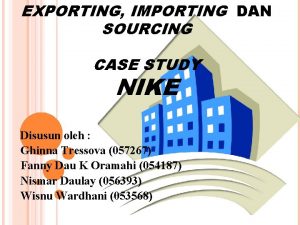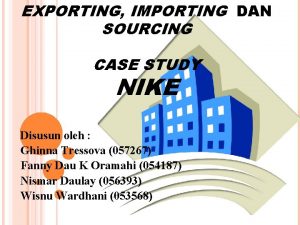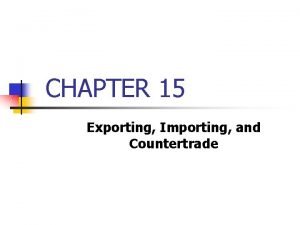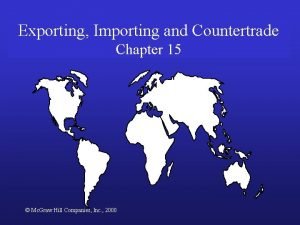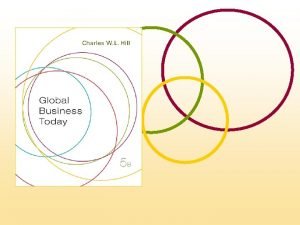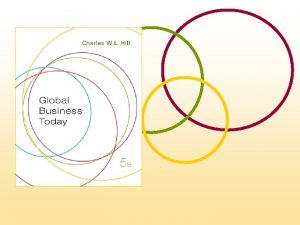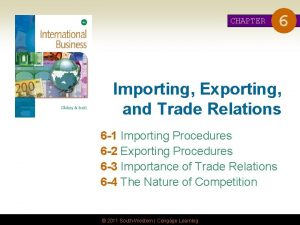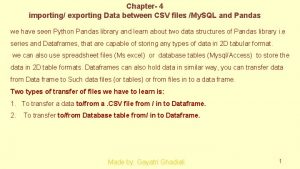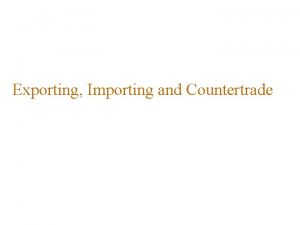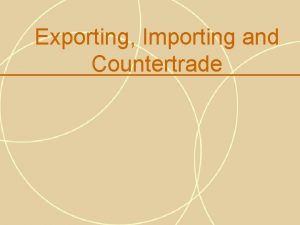Importing Exporting and Sourcing Chapter 8 Dr Inda
































- Slides: 32

Importing, Exporting, and Sourcing Chapter 8 Dr Inda Sukati Faculty of Management Universiti Teknologi Malaysia 1

Introduction • This chapter looks at: – Export selling and export marketing – Organizational export activities – National policies on imports and exports – Tariff systems – Key export participants © 2011 Pearson Education, Inc. 8 -2

Export selling and export marketing • Export selling does not involve tailoring the product, the price, or the promotional material to suit the requirements of global markets. The only marketing mix element that differs is the “place”; that is, the country where the product is sold. It is involves selling the same product, at the same price, with the same promotional tools in a different place © 2011 Pearson Education, Inc. 8 -3

Export selling and export marketing • Export marketing targets the customer in the context of the total market environment. The export marketer does not simply take the domestic product “as is” and sell it to international customers. To the export marketer, the product offered in the home market represents a starting point. It is modified as needed to meet the preferences of international target markets © 2011 Pearson Education, Inc. 8 -4

Export Marketing Requires: • An understanding of the target market environment • The use of market research and identification of market potential • Decisions concerning product design, pricing, distribution and channels, advertising, and communications © 2011 Pearson Education, Inc. 8 -5

Organizational Export Activities Exporting is becoming increasingly important as companies in all parts of the world step up their efforts to supply and service markets outside their national boundaries. Research has shown that exporting is essentially a developmental process that can be divided into the following distinct stages: 1. The firm is unwilling to export; it will not even fill an unsolicited export order. This may be due to perceived lack of time (“too busy to fill the order”) or to apathy or ignorance. 2. The firm fills unsolicited export orders but does not pursue unsolicited orders. Such a firm is an export seller. 3. The firm explores the feasibility of exporting (this stage may bypass Stage 2). 4. The firm exports to one or more markets on a trial basis. 5. The firm is an experienced exporter to one or more markets. © 2011 Pearson Education, Inc. 8 -6

Organizational Export Activities 6. After this success, the firm pursues country- or regionfocused marketing based on certain criteria (e. g. , all countries where English is spoken or all countries where it is not necessary to transport by water). 7. The firm evaluates global market potential before screening for the “best” target markets to include in its marketing strategy and plan. All markets—domestic and international— are regarded as equally worthy of consideration. © 2011 Pearson Education, Inc. 8 -7

Potential Export Problems © 2011 Pearson Education, Inc. 8 -8

National Policies Governing Exports and Imports • Most nations encourage exports and restrict imports • Goods and services imported into the U. S. almost doubled in seven years • In 2008, the total was $2. 5 trillion © 2011 Pearson Education, Inc. 8 -9

What four countries make up the “Four Tigers? ” • The four tigers – Singapore, South Korea, Taiwan, and Hong Kong – learned from the Japanese experience and built strong export-based economies of their own. • Although Asia’s “economic bubble” burst in 1997 as a result of uncontrolled growth, Japan and the tigers are moving forward in the twenty-first century at a more moderate. © 2011 Pearson Education, Inc. 8 -10

Share of U. S. Apparel Market by Exporting Country, 2010 1. China 39. 1 2. Vietnam 8. 2 3. Indonesia 6. 1 4. Bangladesh 5. 5 5. Mexico 4. 9 6. India 4. 3 7. Honduras 3. 3 8. Cambodia 3. 1 9. El Salvador 2. 3 10. Pakistan © 2011 Pearson Education, Inc. 2. 0 8 -11

Government Programs that Support Exports • Tax incentives • Subsidies • Governmental assistance • Free trade zones © 2011 Pearson Education, Inc. 8 -12

Government Programs that Support Exports Tax incentives treat earnings from export activities preferentially either by applying a lower rate to earnings from these activities or by refunding taxes already paid on income associated with exporting. © 2011 Pearson Education, Inc. 8 -13

Government Programs that Support Exports Subsidies: Governments also support export performance by providing outright subsidies, which are direct or indirect financial contributions or incentives that benefit producers. Subsidies can severely distort trade patterns when less competitive but subsidized producers displace competitive producers in world markets. © 2011 Pearson Education, Inc. 8 -14

Government Programs that Support Exports • Governmental assistance: The third support area is governmental assistance to exporters. Companies can avail themselves of a great deal of government information concerning the location of markets and credit risks. Assistance may also be oriented toward export promotion. Government agencies at various levels often take the lead in setting up trade fairs and trade missions designed to promote sales to foreign customers © 2011 Pearson Education, Inc. 8 -15

Governmental Actions to Discourage Imports and Block Market Access • Tariffs • Import controls • Nontariff barriers – – – Quotas Discriminatory procurement policies Restrictive customs procedures Arbitrary monetary policies Restrictive regulations © 2011 Pearson Education, Inc. Portland Customs Center 8 -16

Tariff Systems • Single-column tariff – Simplest type of tariff – Schedule of duties in which rate applies to imports from all countries on the same basis • Two-column tariff – General duties plus special duties apply © 2011 Pearson Education, Inc. 8 -17

Tariff Systems Sample Rates of Duty for U. S. Imports © 2011 Pearson Education, Inc. 8 -18

Preferential Tariff • Reduced tariff rate applied to imports from certain countries • GATT prohibits the use, with three exceptions: – Historical preference arrangements already existed – Preference is part of formal economic integration treaty – Industrial countries are permitted to grant preferential market access to LDCs © 2011 Pearson Education, Inc. 8 -19

Customs Duties • Ad valorem duty – Expressed as percentage of value of goods • Specific duty – Expressed as specific amount of currency per unit of weight, volume, length, or other unit of measurement • Compound or mixed duties – Apply both ad valorem and specific on the same items © 2011 Pearson Education, Inc. 8 -20

Other Duties and Import Charges • Anti-dumping Duties – Dumping is the sale of merchandise in export markets at unfair prices – Special import charges equal to the dumping margin • Countervailing Duties • Variable Import Levies • Temporary Surcharges © 2011 Pearson Education, Inc. 8 -21

Key Export Participants • Foreign purchasing agents • Export brokers • Export merchants • Export management companies © 2011 Pearson Education, Inc. • Export distributor • Export commission representative • Cooperative exporter • Freight forwarders • Manufacturer’s export representatives 8 -22

Organizing for Exporting in the Manufacturer’s Country • Exports can be handled – As a part-time activity performed by domestic employees – Through an export partner – Through an export department within an international division – For multi-divisional companies; each possibility exists for each division © 2011 Pearson Education, Inc. 8 -23

Organizing for Exporting in the Market Country • Direct market representation – Advantages: control and communications • Representation by independent intermediaries – Advantages: best for situations with small sales volume © 2011 Pearson Education, Inc. 8 -24

Export Financing and Methods of Payment • • • Documentary credits (letter of credit) Documentary collections (bill of exchange) Cash in advance Sales on open account Sales on consignment basis © 2011 Pearson Education, Inc. 8 -25

Flow Chart of Documentary Credit © 2011 Pearson Education, Inc. 8 -26

© 2011 Pearson Education, Inc. 8 -27

Customs Trade Partnership Against Terrorism • The U. S. Customs and Border Patrol inspects cargo • C-TPAT aims to have businesses certify their security and that of their partners • They get inspection priority © 2011 Pearson Education, Inc. 8 -28

Sourcing • Must emphasize benefits of sourcing from country other than home country • Must assess vision and values of company leadership • Advantage can be gained by – Concentrating some of the marketing activities in a single location – Leveraging company’s know-how – Tapping opportunities for product development and R&D © 2011 Pearson Education, Inc. 8 -29

Duty Drawback • Refunds of duties paid on imports that are processed or incorporated into other goods AND re-exported • Reduce the price of imported production inputs • Used in the U. S. to encourage exports • After NAFTA, U. S. reduced drawbacks on exports to Canada and Mexico • China had to reduce drawbacks in order to join the WTO © 2011 Pearson Education, Inc. 8 -30

Factors that Affect Sourcing • • Management vision Factor costs and conditions Customer needs Logistics Country infrastructure Political risk Exchange rate, availability, and convertibility of local money © 2011 Pearson Education, Inc. 8 -31

Exercises 1. What is the difference between export marketing and export selling? 2. Describe the stages a company typically goes through as it learns about exporting. 3. What criteria should company management consider when making sourcing decisions? © 2011 Pearson Education, Inc. 8 -32
 Insourching
Insourching What is export management
What is export management The great promise of exporting is that
The great promise of exporting is that Reactive metal paint
Reactive metal paint Direct exporting
Direct exporting Why did britain begin exporting opium to china?
Why did britain begin exporting opium to china? Export licensing requirements
Export licensing requirements Sinking vs sourcing
Sinking vs sourcing What is sourcing in history
What is sourcing in history Sourcing and procurement bu
Sourcing and procurement bu The role of sourcing planning and analysis is
The role of sourcing planning and analysis is Advantages and disadvantages of global sourcing
Advantages and disadvantages of global sourcing Ariba direct material sourcing
Ariba direct material sourcing Unops e sourcing
Unops e sourcing Unops esourcing
Unops esourcing Tailored sourcing supply chain
Tailored sourcing supply chain Smart sourcing rotterdam
Smart sourcing rotterdam Capacity aggregation supply chain
Capacity aggregation supply chain Sourcing decision cycle framework
Sourcing decision cycle framework Happy documents
Happy documents Procurement low cost country sourcing
Procurement low cost country sourcing Sourcing contextualization corroboration close reading
Sourcing contextualization corroboration close reading Auction sourcing tool
Auction sourcing tool Organizations may shy away from cloud computing because
Organizations may shy away from cloud computing because Challenges facing global sourcing
Challenges facing global sourcing Drug intermediates and apis procurement
Drug intermediates and apis procurement 7 step strategic sourcing process
7 step strategic sourcing process Ariba sourcing user guide
Ariba sourcing user guide Sourcing maturity model
Sourcing maturity model Value based sourcing
Value based sourcing 7 step strategic sourcing process
7 step strategic sourcing process Lean sourcing
Lean sourcing Talent sourcing
Talent sourcing

